Response of Shallow-Water Temperature and Significant Wave Height to Sequential Tropical Cyclones in the Northeast Beibu Gulf
Abstract
1. Introduction
2. Data and Methodology
2.1. Buoy Observation Data
2.2. Reanalysis Data
2.3. SWAN and ADCIRC Model Data
2.4. Parameter Calculation Method
3. Sea Surface Temperature Response
3.1. Offshore Response
3.2. Nearshore Response
3.3. Sea Surface Temperature Change Mechanism
3.3.1. Heat Flux at the Sea Surface
3.3.2. Ekman Pumping Rate
4. Effective Wave Height Response
4.1. Offshore Response
4.2. Nearshore Response
4.3. Mechanism of Wave Changes
5. Discussion
5.1. Different Responses in Nearshore and Offshore Areas
5.2. Impacts of Sequential Tropical Cyclones
6. Conclusions
Author Contributions
Funding
Data Availability Statement
Acknowledgments
Conflicts of Interest
References
- Pasquero, P.C. Role of sst patterns on surface wind modulation of a heavy midlatitude precipitation event. J. Geophys. Res. Atmos. 2018, 123, 9081–9096. [Google Scholar]
- Li, D.Y.; Tan, Z.M. The role of ocean-atmosphere interactions in tropical cyclone intensity predictability. J. Atmos. Sci. 2023, 80, 1213–1226. [Google Scholar] [CrossRef]
- Warner, J.C.; Armstrong, B.; He, R.; Zambon, J.B. Development of a Coupled Ocean–Atmosphere–Wave–Sediment Transport (COAWST) modeling system. Ocean Model. 2010, 35, 230–244. [Google Scholar] [CrossRef]
- Olabarrieta, M.; Warner, J.C.; Armstrong, B.; Zambon, J.B.; He, R. Ocean–atmosphere dynamics during Hurricane Ida and Nor’Ida: An application of the coupled ocean–atmosphere–wave–sediment transport (COAWST) modeling system. Ocean Model. 2012, 43–44, 112–137. [Google Scholar] [CrossRef]
- Black, P.; Dasaro, E.; Drennan, W.; French, J.; Niiler, P.; Sanford, T.; Terrill, E.; Walsh, E.; Zhang, J. Air–Sea Exchange in Hurricanes: Synthesis of Observations from the Coupled Boundary Layer Air–Sea Transfer Experiment. Bull. Am. Meteorol. Soc. 2007, 88, 357–374. [Google Scholar] [CrossRef]
- Emanuel, K. Contribution of tropical cyclones to meridional heat transport by the oceans. J. Geophys. Res. Atmos. 2001, 106, 14771–14781. [Google Scholar] [CrossRef]
- Chelton, D.B.; Schlax, M.G.; Samelson, R.M. Summertime coupling between sea surface temperature and wind stress in the California Current System. J. Phys. Oceanogr. 2007, 37, 495–517. [Google Scholar] [CrossRef]
- Chelton, D.B.; Esbensen, S.K.; Schlax, M.G.; Thum, N.; Freilich, M.H.; Wentz, F.J.; Gentemann, C.L.; McPhaden, M.J.; Schopf, P.S. Observations of coupling between surface wind stress and sea surface temperature in the eastern tropical Pacific. J. Clim. 2001, 14, 1479–1498. [Google Scholar] [CrossRef]
- D’Asaro, E.A.; Sanford, T.B.; Niiler, P.P.; Terrill, E.J. Cold wake of hurricane Frances. Geophys. Res. Lett. 2007, 34, L1560. [Google Scholar] [CrossRef]
- Korty, R.L.; Emanuel, K.A.; Scott, J.R. Tropical cyclone–induced upper-ocean mixing and climate: Application to equable climates. J. Clim. 2008, 21, 638–654. [Google Scholar] [CrossRef]
- Fedorov, A.V.; Brierley, C.M.; Emanuel, K. Tropical cyclones and permanent El Niño in the early Pliocene epoch. Nature 2010, 463, 1066–1070. [Google Scholar] [CrossRef]
- Pasquero, C.; Desbiolles, F.; Meroni, A.N. Air-sea interactions in the cold wakes of tropical cyclones. Geophys. Res. Lett. 2021, 48, e2020GL091185. [Google Scholar] [CrossRef]
- Zhou, L.; Chen, D.; Lei, X.; Wang, W.; Wang, G.; Hang, G. Progress and Perspective on Interaction between Ocean and Typhoon. Sci. Bull. 2019, 64, 60–72. [Google Scholar] [CrossRef]
- Jiang, X.; Liu, C.; Mo, H.; Wang, Y. The impact of air-sea interaction on typhoon structure. J. Trop. Meteorol. 2010, 26, 55–59. [Google Scholar]
- Soloviev, A.V.; Lukas, R.; Donelan, M.A.; Haus, B.K.; Ginis, I. The air-sea interface and surface stress under tropical cyclones. Sci. Rep. 2014, 4, 5306. [Google Scholar] [CrossRef] [PubMed]
- Li, F.N.; Song, J.B.; He, H.L.; Li, S.; Li, X.; Guan, S.D. Assessment of surface drag coefficient parametrizations based on observations and simulations using the Weather Research and Forecasting model. Atmos. Ocean. Sci. Lett. 2016, 9, 327–336. [Google Scholar] [CrossRef]
- Tian, D.; Zhang, H.; Zhang, W.; Zhou, F.; Sun, X.; Zhou, Y.; Ke, D. Wave glider observations of surface waves during three tropical cyclones in the South China Sea. Water 2020, 12, 1331. [Google Scholar] [CrossRef]
- Nystrom, R.G.; Chen, X.; Zhang, F.; Davis, C.A. Nonlinear impacts of surface exchange coefficient uncertainty on tropical cyclone intensity and air-sea interactions. Geophys. Res. Lett. 2020, 47, e2019GL085783. [Google Scholar] [CrossRef]
- Lee, C.Y.; Chen, S.S. Symmetric and asymmetric structures of hurricane boundary layer in coupled atmosphere–wave–ocean models and observations. J. Atmos. Sci. 2012, 69, 3576–3594. [Google Scholar] [CrossRef]
- Liu, Z.; Xu, J.; Zhu, B.; Sun, C.; Zhang, L. The upper ocean response to tropical cyclones in the northwestern Pacific analyzed with Argo data. Chin. J. Oceanol. Limnol. 2007, 25, 123–131. [Google Scholar] [CrossRef]
- Price, J.F. Upper ocean response to a hurricane. J. Phys. Oceanogr. 1981, 11, 153–175. [Google Scholar] [CrossRef]
- Black, W.J.; Dickey, T.D. Observations and analyses of upper ocean responses to tropical storms and hurricanes in the vicinity of Bermuda. J. Geophys. Res. Ocean. 2008, 113, C0800. [Google Scholar] [CrossRef]
- Yang, X.; Tang, D. Location of sea surface temperature cooling induced by typhoon in the South China Sea. J. Trop. Oceanogr. 2010, 29, 26–31. [Google Scholar]
- Sadhuram, Y. (Ed.) Record Decrease of Sea Surface Temperature Following the Passage of a Super Cyclone over the Bay of Bengal; Indian Academy of Sciences: Bengaluru, India, 2004. [Google Scholar]
- Xie, L.; He, C.; Li, M.; Tian, J.; Jing, Z. Response of sea surface temperature to typhoon passages over the upwelling zone east of Hainan Island. Adv. Mar. Sci. 2017, 35, 8–19. [Google Scholar]
- Shi, Y.; Xie, L.; Zheng, Q.; Zhang, S.; Li, M.; Li, J. Unusual coastal ocean cooling in the northern South China Sea by a katabatic cold jet associated with Typhoon Mujigea (2015). Acta Oceanol. Sin. 2019, 38, 62–75. [Google Scholar] [CrossRef]
- Li, Y.; Wang, A.; Qiao, L.; Fang, J.; Chen, J. The impact of typhoon Morakot on the modern sedimentary environment of the mud deposition center off the Zhejiang–Fujian coast, China. Cont. Shelf Res. 2012, 37, 92–100. [Google Scholar] [CrossRef]
- Milliman, J.; Lin, S.; Kao, S.; Liu, J.; Liu, C.; Chiu, J.; Lin, Y. Short-term changes in seafloor character due to flood-derived hyperpycnal discharge: Typhoon Mindulle, Taiwan, July 2004. Geology 2007, 35, 779. [Google Scholar] [CrossRef]
- Yang, G.-B.; Lü, L.-G.; Wang, G.-S.; Jiang, Y.; Liu, Z.-W.; Yang, C.-M.; Chen, Z.; Zhang, C. Coastal sound-field change due to typhoon-induced sediment warming. J. Acoust. Soc. Am. 2016, 140, EL242–EL246. [Google Scholar] [CrossRef]
- Shi, H.; Cao, X.; Wen, X.; Wu, Q.; Guo, P. Numerical model research of the spatial characteristics of typhoon waves in the northwestern of the south China sea near Hainan island during the transmit of typhoon “Son-Tink”. Mar. Environ. Sci. 2016, 35, 366–373. [Google Scholar]
- Shi, M.; Chen, B.; Ding, Y.; Wu, L.; Zheng, B. Wind effects on spread of runoffs in Beibu Bay. Guangxi Sci. 2016, 23, 485–491. [Google Scholar]
- Rasheed, M.A.; Unsworth, R.K.F. Long-term climate-associated dynamics of a tropical seagrass meadow: Implications for the future. Mar. Ecol. Prog. Ser. 2011, 422, 93–103. [Google Scholar] [CrossRef]
- Zhang, W.; Zheng, Z.; Zhang, T.; Chen, T. Strengthened marine heatwaves over the Beibu Gulf coral reef regions from 1960 to 2017. Haiyang Xuebao 2020, 42, 45–52. [Google Scholar]
- Micheli, F.; Bishop, M.J.; Peterson, C.H.; Rivera, J. Alteration of seagrass species composition and function over two decades. Ecol. Monogr. 2008, 78, 225–244. [Google Scholar] [CrossRef]
- Fan, H.Q.; Peng, S.; Shi, Y.J.; Zheng, X.W. The situations of seagrass resources and researches along Guangxi coasts of Beibu Gulf. Guangxi Sci. 2007, 14, 289–295. [Google Scholar]
- Wu, Z.J.; Chen, S.Q.; Wang, D.R.; Cai, Z.F.; Zhang, G.X.; Tu, Z.G.; Li, Y.C. The health assessment of the sea grass bed ecosystem in the east coast of Hainan Islands. Mar. Sci. 2014, 38, 67–74. [Google Scholar]
- Deng, C.B.; Lian, X.Q. Conservation and management of rare and endangered marine mammals in the Beibu Gulf in Guangxi. Chin. J. Guangxi Acad. Sci. 2004, 20, 123–126. [Google Scholar]
- Chen, Y.; Lin, X.; Luo, J.; You, Y. Analysis of Spatial and Temporal Pattern of Tropical Cyclone Landing on Hainan lsland in Recent 31 Years. Green Technol. 2021, 23, 4–6+20. [Google Scholar]
- Emanuel, K. Increasing destructiveness of tropical cyclones over the past 30 years. Nature 2005, 436, 686–688. [Google Scholar] [CrossRef] [PubMed]
- Walsh, K.J.E.; McBride, J.L.; Klotzbach, P.J.; Balachandran, S.; Camargo, S.J.; Holland, G.; Knutson, T.R.; Kossin, J.P.; Lee, T.-C.; Sobel, A.; et al. Tropical cyclones and climate change. Wiley Interdiscip. Rev. Clim. Change 2016, 7, 65–89. [Google Scholar] [CrossRef]
- Wang, S.; Toumi, R. Recent migration of tropical cyclones toward coasts. Science 2021, 371, 514–517. [Google Scholar] [CrossRef]
- Liu, G.; Li, X.; Wang, J.; Kou, Y.; Wang, X. Research on the statistical characteristics of typhoon frequency. Ocean Eng. 2020, 209, 107489. [Google Scholar] [CrossRef]
- Zhang, Q.; Wu, L.; Liu, Q. Tropical cyclone damages in China 1983–2006. Bull. Am. Meteorol. Soc. 2009, 90, 489–496. [Google Scholar] [CrossRef]
- Jiang, C.; Zhao, B.; Deng, B.; Wu, Z. Numerical simulation of typhoon storm surge in the Beibu Gulf and hazardous analysis at key areas. Mar. Forecast. 2017, 34, 32–40. [Google Scholar]
- Zhang, M.; Jie, M.; Dai, Z. Impacts of sea-level rise on storm surge in the Beibu Gulf: A case study on Typhoon Son-Tinh in 2012. Mar. Sci. Bull. 2021, 40, 309–318. [Google Scholar]
- Dong, Z.-H.; Cao, L.-H. The influence on topography and relief in south gulf Beibu and suspending of pipe caused by typhoon. Mar. Technol. 2004, 23, 24–28+34. [Google Scholar]
- Li, X.; Fu, D.; Zhang, Y.; Liu, D.; Ding, Y.; Wang, W.; Luan, H.; Jiang, C. The impacts of super typhoon Rammasun on the environment of the northwestern South China Sea. J. Trop. Oceanogr. 2016, 35, 19–28. [Google Scholar]
- Liu, S.; Li, J.; Sun, L.; Wang, G.; Tang, D.; Huang, P.; Yan, H.; Gao, S.; Liu, C.; Gao, Z.; et al. Basin-wide responses of the South China Sea environment to super typhoon Mangkhut (2018). Sci. Total Environ. 2020, 731, 139093. [Google Scholar] [CrossRef]
- Chen, Y.; Ren, C.; Feng, Y.; Shi, H.; Pan, G.; Cooper, M.; Zhao, H. Different Responses of Chlorophyll a to the Passage of the Tropical Storm Wipha (2019) in the Coastal Waters of the Northern Beibu Gulf. Front. Mar. Sci. 2022, 9, 887240. [Google Scholar] [CrossRef]
- GB/T 19201-2006; Grade of Tropical Cyclones. China Meteorological Administration Policy and Regulations Department: Beijing, China, 2006.
- Booij, N.; Ris, R.C.; Holthuijsen, L.H. A third-generation wave model for coastal regions: 1. Model description and validation. J. Geophys. Res. Ocean. 1999, 104, 7649–7666. [Google Scholar] [CrossRef]
- Westerink, J.J.; Luettich, R.A.; Baptists, A.M.; Scheffner, N.W.; Farrar, P. Tide and storm surge predictions using finite element model. J. Hydraul. Eng. 1992, 118, 1373–1390. [Google Scholar] [CrossRef]
- Kolar, R.L.; Gray, W.G.; Westerink, J.J.; Luettich, R.A., Jr. Shallow water modeling in spherical coordinates: Equation formulation, numerical implementation, and application. J. Hydraul. Res. 1994, 32, 3–24. [Google Scholar] [CrossRef]
- Hao, Z.; Tu, Q.; Zhang, S.; Chen, J.; Pan, D. Wind-Wave relationship model and analysis of typhoon wave fields in the south China sea from HY-2A Satellite observations. IEEE J. Sel. Top. Appl. Earth Obs. Remote Sens. 2020, 13, 4008–4015. [Google Scholar] [CrossRef]
- Ma, L.; Qing, Z.; Duan, Y.; Du, B. Ocean impact on the development of cyclone over the East China Sea. Acta Oceanol. Sin. 2002, S1, 112–122. [Google Scholar]
- Yang, J.; Hong, B. Response of the Upper Ocean in the Northeastern South China Sea to Typhoon ‘Lianhua’. Mar. Bull. 2021, 40, 161–171. [Google Scholar]
- Chen, X.; Qiu, C.; Zhang, H.; Liu, D.; Shi, H.; Ma, Y.; Wang, D. Response of the Marine Environment near Jitimen in the Pearl River Estuary to Typhoon. Oceanol. Limnol. Sin. 2022, 53, 872–881. [Google Scholar]
- Prasad, T.; Hogan, P.J. Upper-ocean response to Hurricane Ivan in a 1/25 nested Gulf of Mexico HYCOM. J. Geophys. Res. Ocean. 2007, 112, C0401. [Google Scholar] [CrossRef]
- Zhang, Z. A Case Study on the Response of the Upper Ocean in the Northwestern Pacific Ocean to Typhoons. Mar. Bull. 2019, 38, 562–568. [Google Scholar]
- Chen, D.; Lei, X.; Wang, W.; Wang, G.; Han, G.; Zhou, L. Response and Modulation Mechanism of the Upper Ocean to Typhoons. Adv. Earth Sci. 2013, 28, 1077–1086. [Google Scholar]
- Halpern, D. Observations of the deepening of the wind-mixed layer in the northeast Pacific Ocean. J. Phys. Oceanogr. 1974, 4, 454–466. [Google Scholar] [CrossRef]
- Zhou, L.; Wang, A.; Wang, Z. Wave spectrum characteristics under typhoon wind forcing in coastal waters of the Beibu Bay through numerical simulation by SWAN. Mar. Sci. Bull. 2010, 12, 1–14. [Google Scholar]
- Chen, T.; Zhou, L.; Wang, Z.; Li, Q. Analysis of Wave and Sea Surface Temperature Changes in the Northern South China Sea during Typhoon ‘Haiou’. Mar. Lake Bull. 2017, 4, 1–11. [Google Scholar]
- Shen, X.; Fan, L.; Chen, G.; Gao, C.; Zhong, X. Numerical Simulation Study of the Wave Field in the South China Sea under the Influence of Typhoon ‘Nianyu’. Waterw. Port 2016, 37, 369–374. [Google Scholar]
- Li, Z.; Meng, Z.; Liu, C.; Mao, K.; Han, S. Study on the Impact of Typhoon ‘Dujuan’ on Upper Ocean Temperature in the Western Pacific Ocean. Mar. Lake Bull. 2020, 3, 24–30. [Google Scholar]
- Xu, W.L.; Su, J. The impact of typhoons on sea surface temperature in the Western North Pacific Ocean. Period. Ocean. Univ. China 2007, 37 (Suppl. Ⅱ), 17–22. [Google Scholar]
- Dac Da, N.; Foltz, G.R.; Balaguru, K.; Fernald, E. Stronger Tropical Cyclone–Induced Ocean Cooling in Near-Coastal Regions Compared to the Open Ocean. J. Clim. 2023, 36, 6447–6463. [Google Scholar] [CrossRef]
- Huang, P.; Sanford, T.B.; Imberger, J. Heat and Turbulent Kinetic Energy Budgets for Surface Layer Cooling Induced by the Passage of Hurricane Frances (2004). J. Geophys. Res. 2009, 114, 2169–9291. [Google Scholar] [CrossRef]
- Jacob, S.D.; Shay, L.K.; Mariano, A.J.; Black, P.G. The 3D oceanic mixed layer response to hurricane Gilbert. J. Phys. Oceanogr. 2000, 30, 1407–1429. [Google Scholar] [CrossRef]
- Chen, S.; Campbell, T.J.; Jin, H.; Gaberšek, S.; Hodur, R.M.; Martin, P. Effect of two-way air-sea coupling in high and low wind speed regimes. Mon. Weather. Rev. 2010, 138, 3579–3602. [Google Scholar] [CrossRef]
- Sui, Y.; Sheng, J.; Tang, D.; Xing, J. Study of storm-induced changes in circulation and temperature over the northern South China Sea during Typhoon Linfa. Cont. Shelf Res. 2022, 249, 104866. [Google Scholar] [CrossRef]
- Prakash, K.R.; Pant, V. Upper oceanic response to tropical cyclone Phailin in the Bay of Bengal using a coupled atmosphere-ocean model. Ocean. Dyn. 2017, 67, 51–64. [Google Scholar] [CrossRef]
- Jyothi, L.; Joseph, S.; Suneetha, P. Surface and sub-surface ocean response to Tropical Cyclone Phailin: Role of pre-existing oceanic features. J. Geophys. Res. Ocean. 2019, 124, 6515–6530. [Google Scholar] [CrossRef]
- Dare, R.A.; McBride, J.L. Sea surface temperature response to tropical cyclones. Mon. Weather. Rev. 2011, 139, 3798–3808. [Google Scholar] [CrossRef]
- Drost, E.J.F.; Lowe, R.J.; Ivey, G.N.; Jines, N.; Péquignet, C.A. The effects of tropical cyclone characteristics on the surface wave fields in Australia’s North West region. Cont. Shelf Res. 2017, 139, 35–53. [Google Scholar] [CrossRef]
- Wang, P.; Sheng, J. A comparative study of wave-current interactions over the eastern Canadian shelf under severe weather conditions using a coupled wave-circulation model. J. Geophys. Res. Ocean. 2016, 121, 5252–5281. [Google Scholar] [CrossRef]
- Sun, Y.; Perrie, W.; Toulany, B. Simulation of wave-current interactions under hurricane conditions using an unstructured-grid model: Impacts on ocean waves. J. Geophys. Res. Ocean. 2018, 123, 3739–3760. [Google Scholar] [CrossRef]
- Lin, S.; Sheng, J.; Ohashi, K.; Song, Q. Wave-current interactions during Hurricanes Earl and Igor in the northwest Atlantic. J. Geophys. Res. Ocean. 2021, 126, e2021JC017609. [Google Scholar] [CrossRef]
- Xiao, L.; Shi, J.; Jiang, G.; Liu, Z. The influence of ocean waves on sea surface current field and sea surface temperature under the typhoon background. Mar. Sci. Bull. 2018, 37, 396–403. [Google Scholar]
- He, S.; Cheng, X.; Fei, J.; Li, X.; Wei, Z.; Huang, X. Thermal response to sequential tropical cyclone passages: Statistic analysis and idealized experiments. Front. Earth Sci. 2023, 11, 1142537. [Google Scholar] [CrossRef]
- Ning, J.; Xu, Q.; Feng, T.; Zhang, H.; Wang, T. Upper ocean response to two sequential tropical cyclones over the northwestern Pacific Ocean. Remote Sens. 2019, 11, 2431. [Google Scholar] [CrossRef]
- Xu, J.; Lei, Z.; Chen, W.; Chen, Q. Comparative Analysis of the Precipitation Effects of Typhoon ‘Lionrock’ and ‘Yuanfeng’ on Xiapu County. Strait Sci. 2022, 6, 8–12. [Google Scholar]
- Xu, F.; Cheng, Z.; Xia, M. Surface wave field under binary typhoons Sarika and Haima (2016) in South China Sea. Estuar. Coast. Shelf Sci. 2020, 241, 106802. [Google Scholar] [CrossRef]

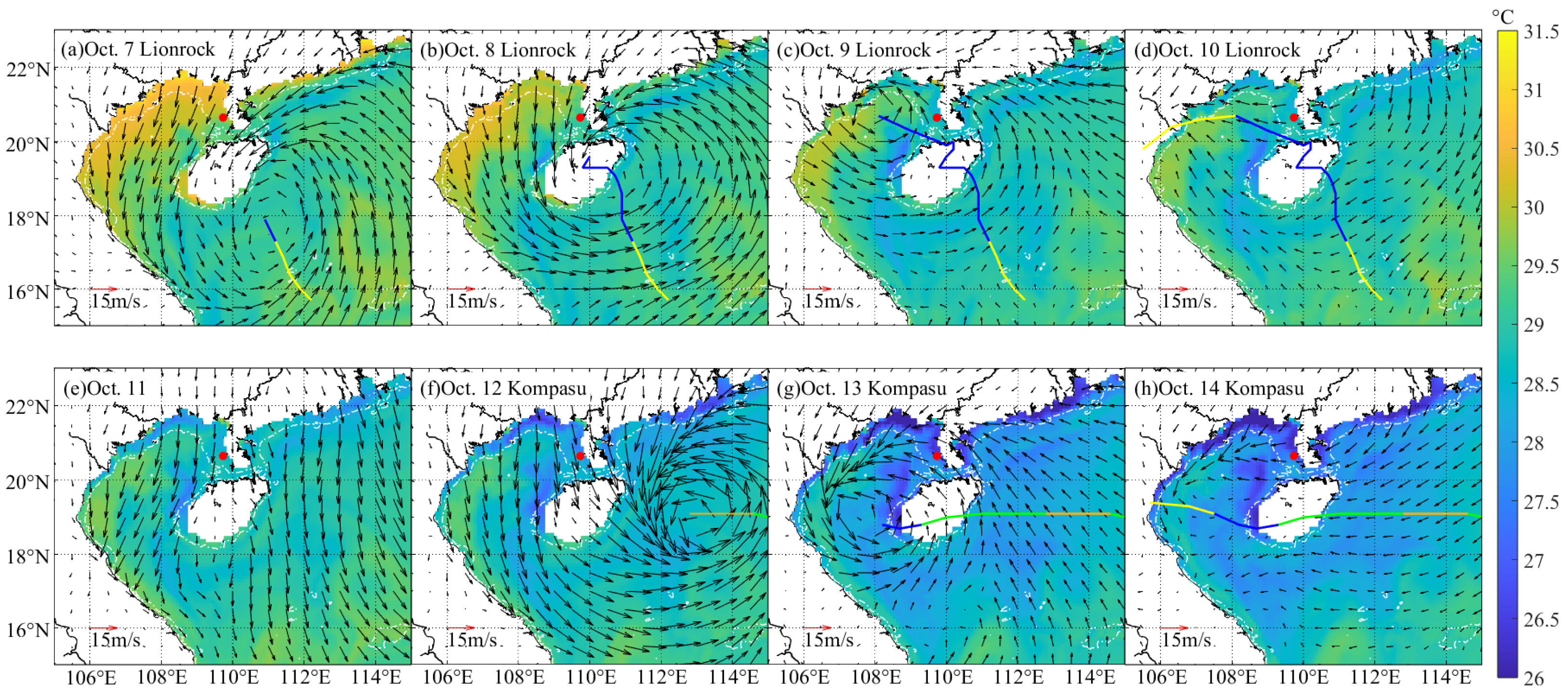
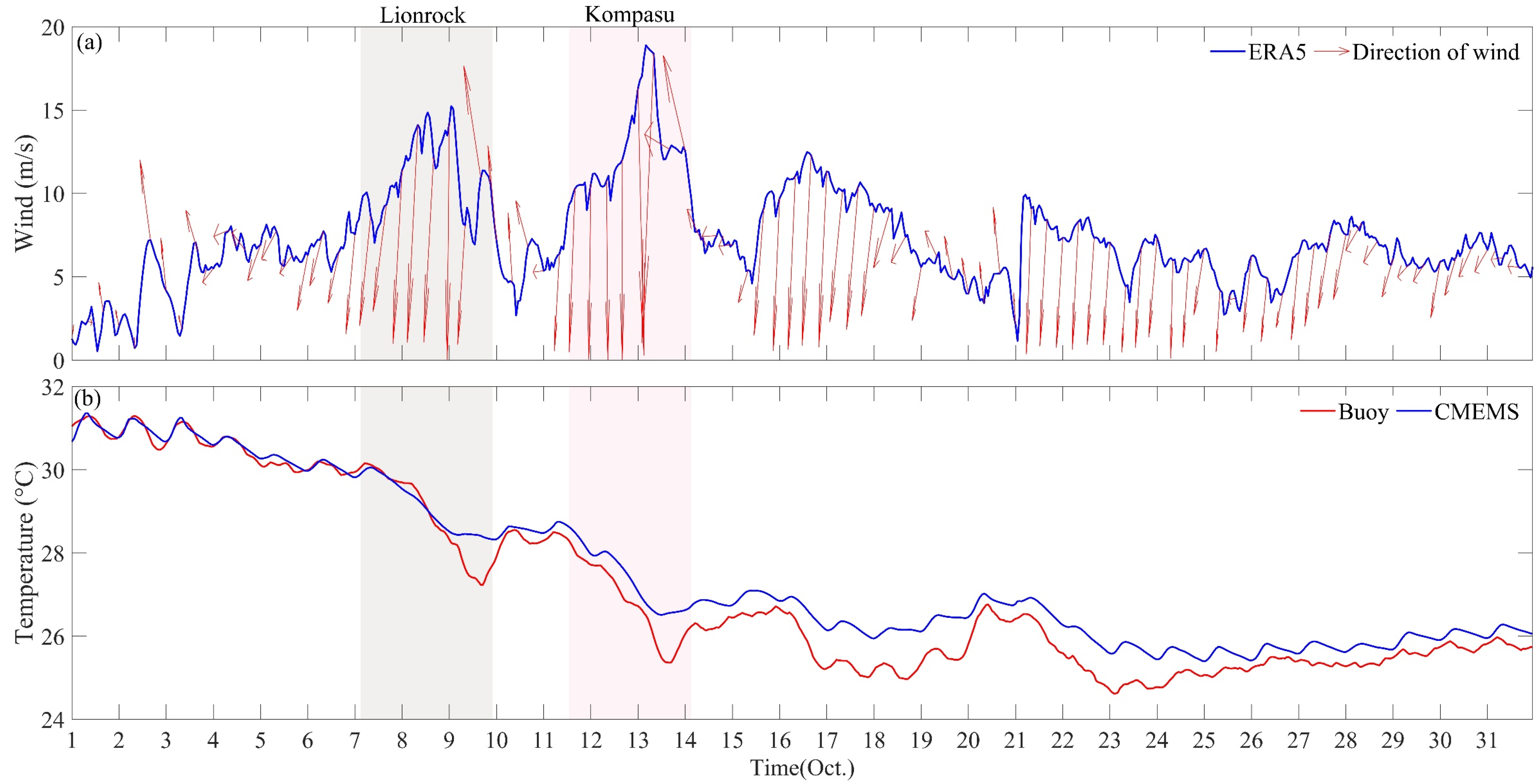
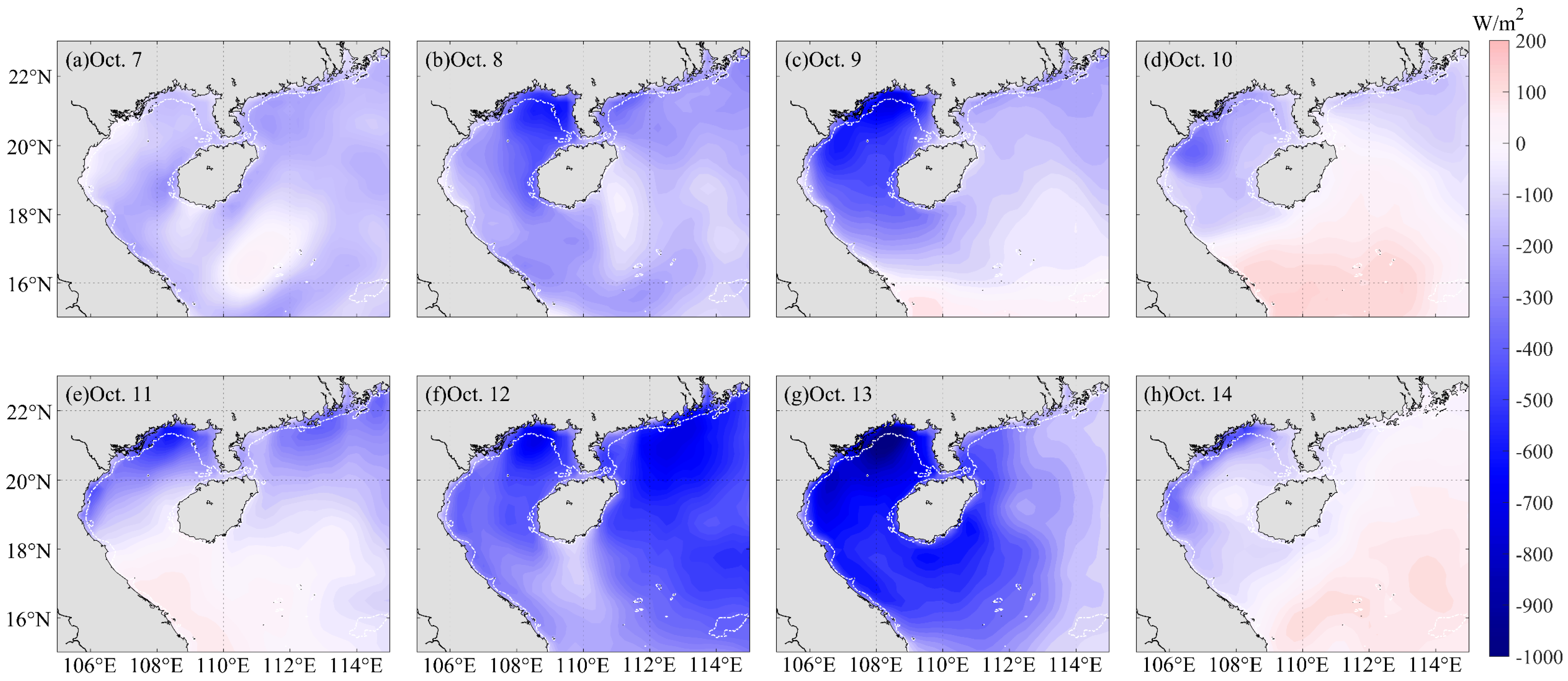
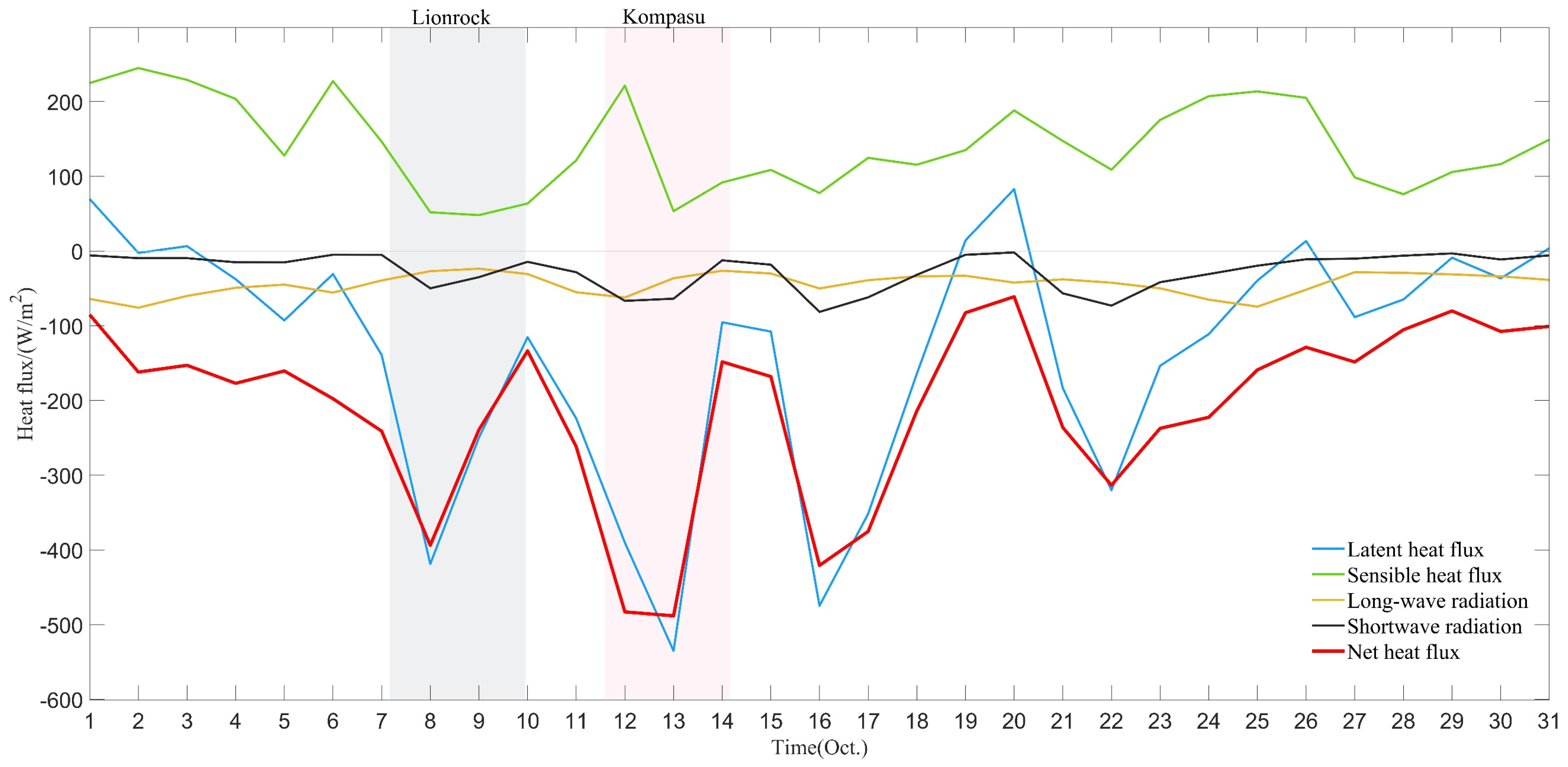

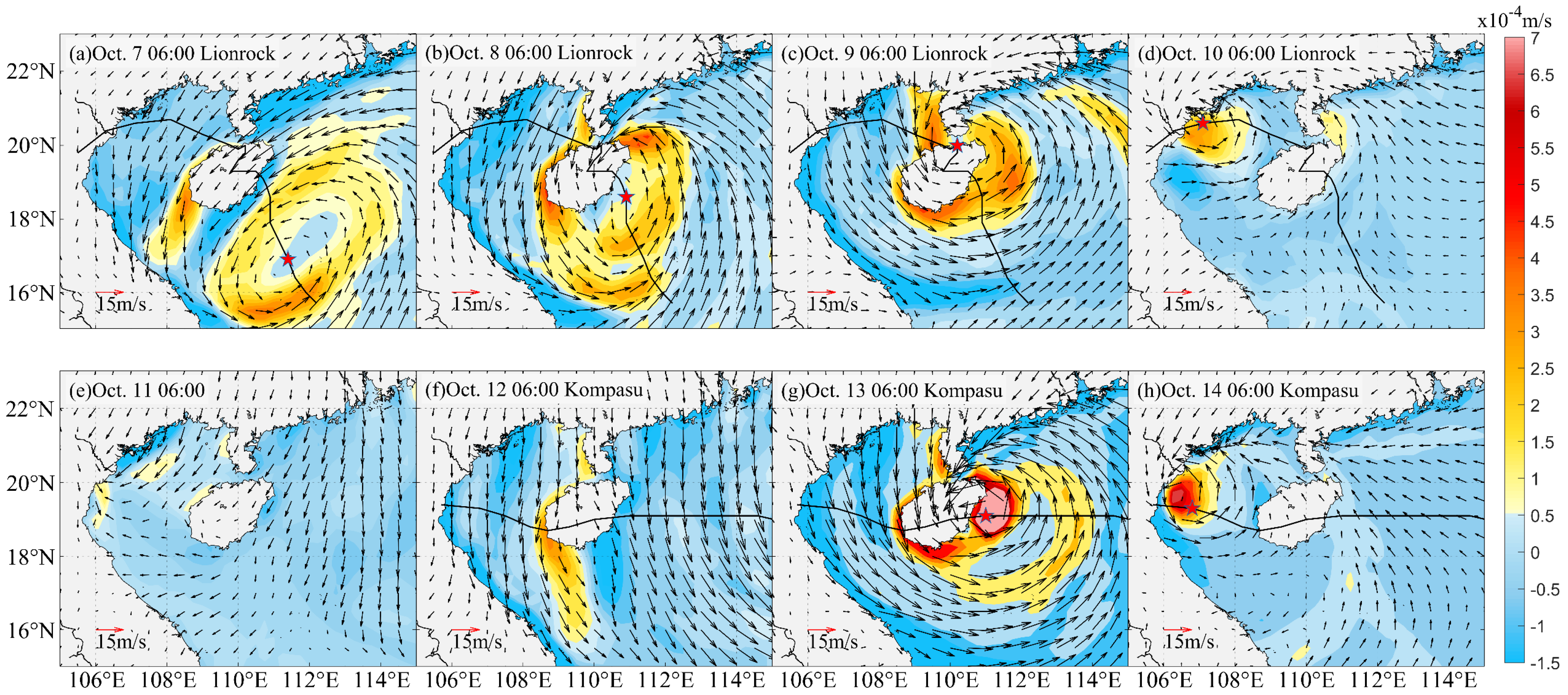
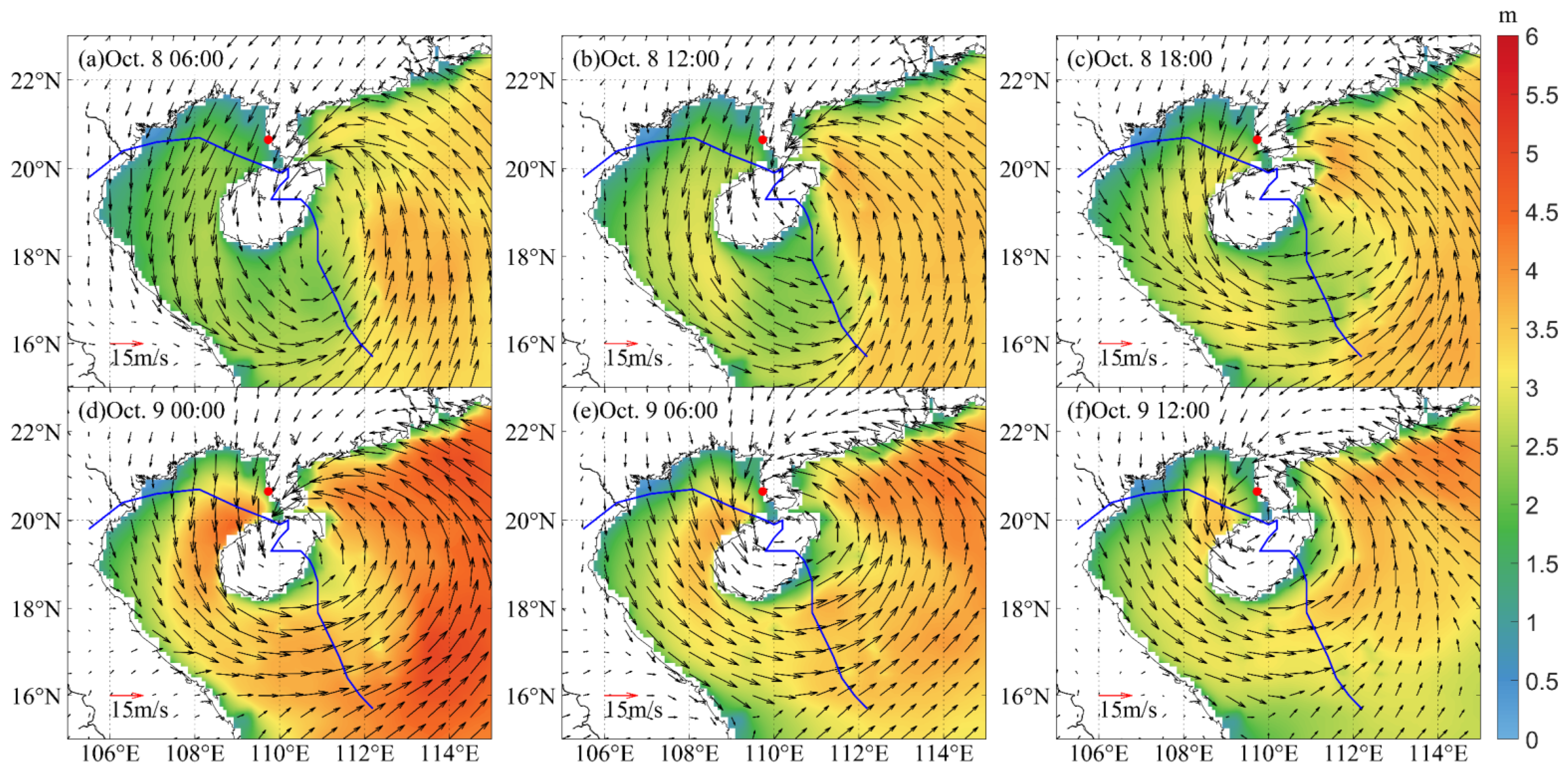
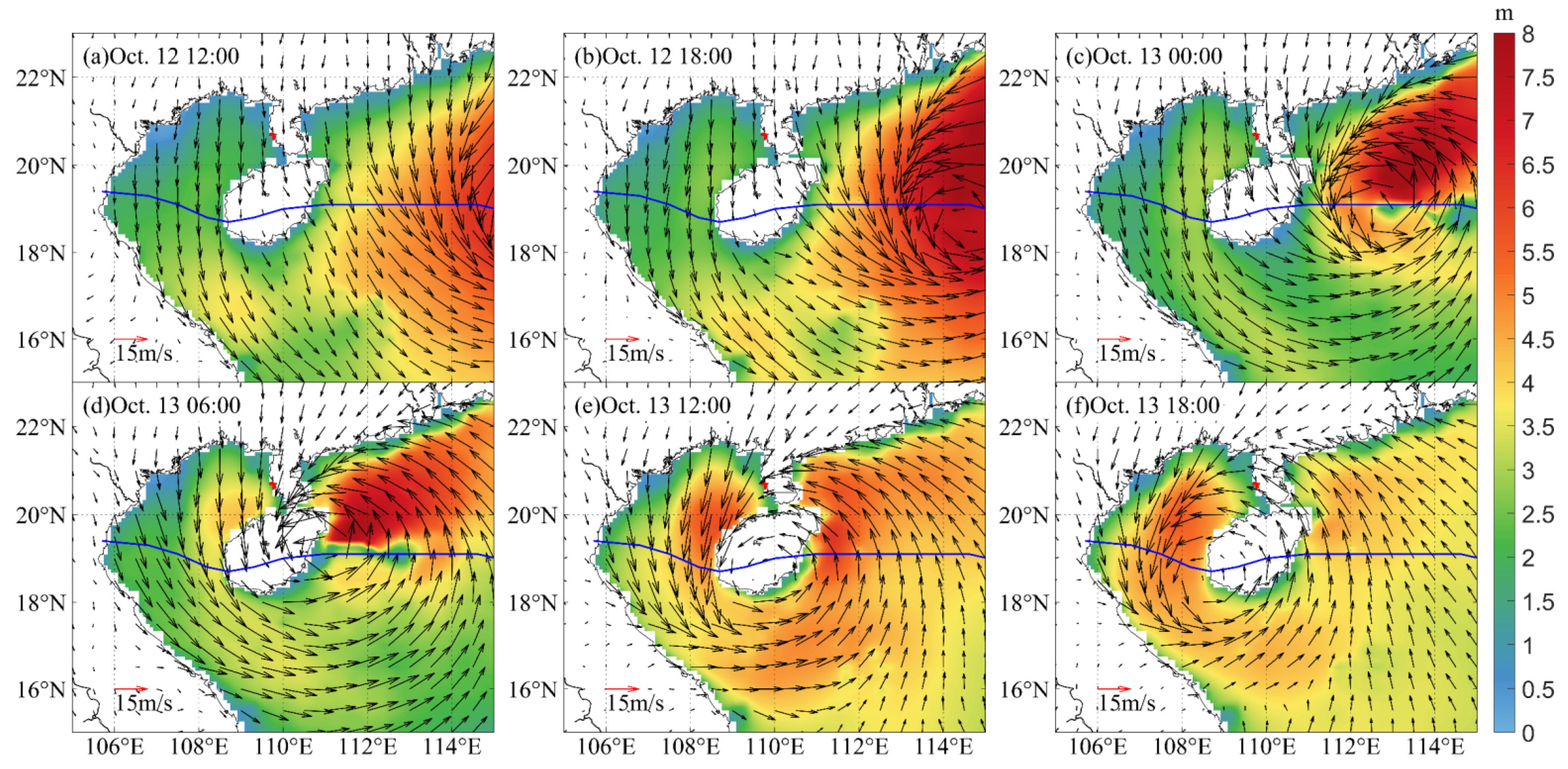
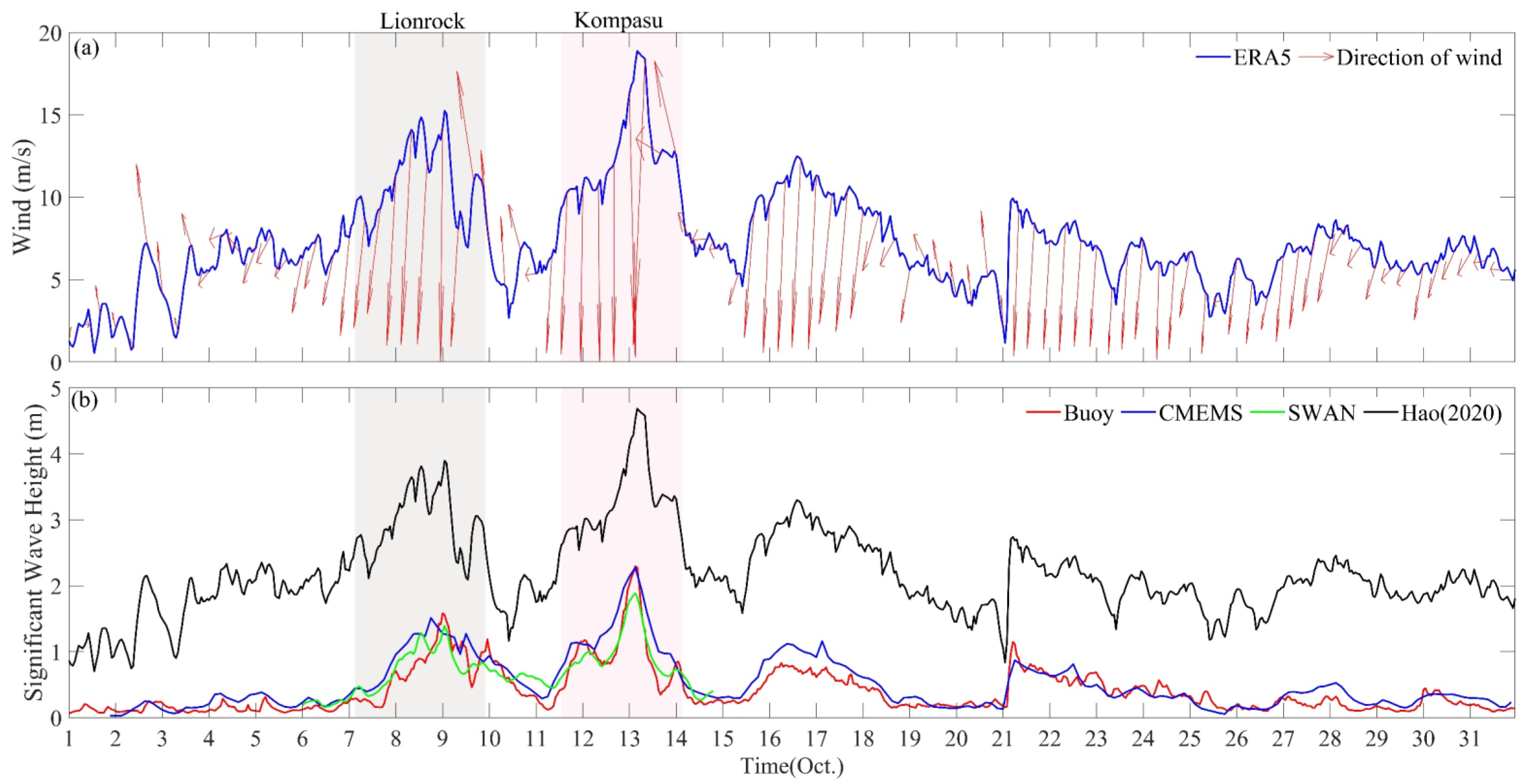
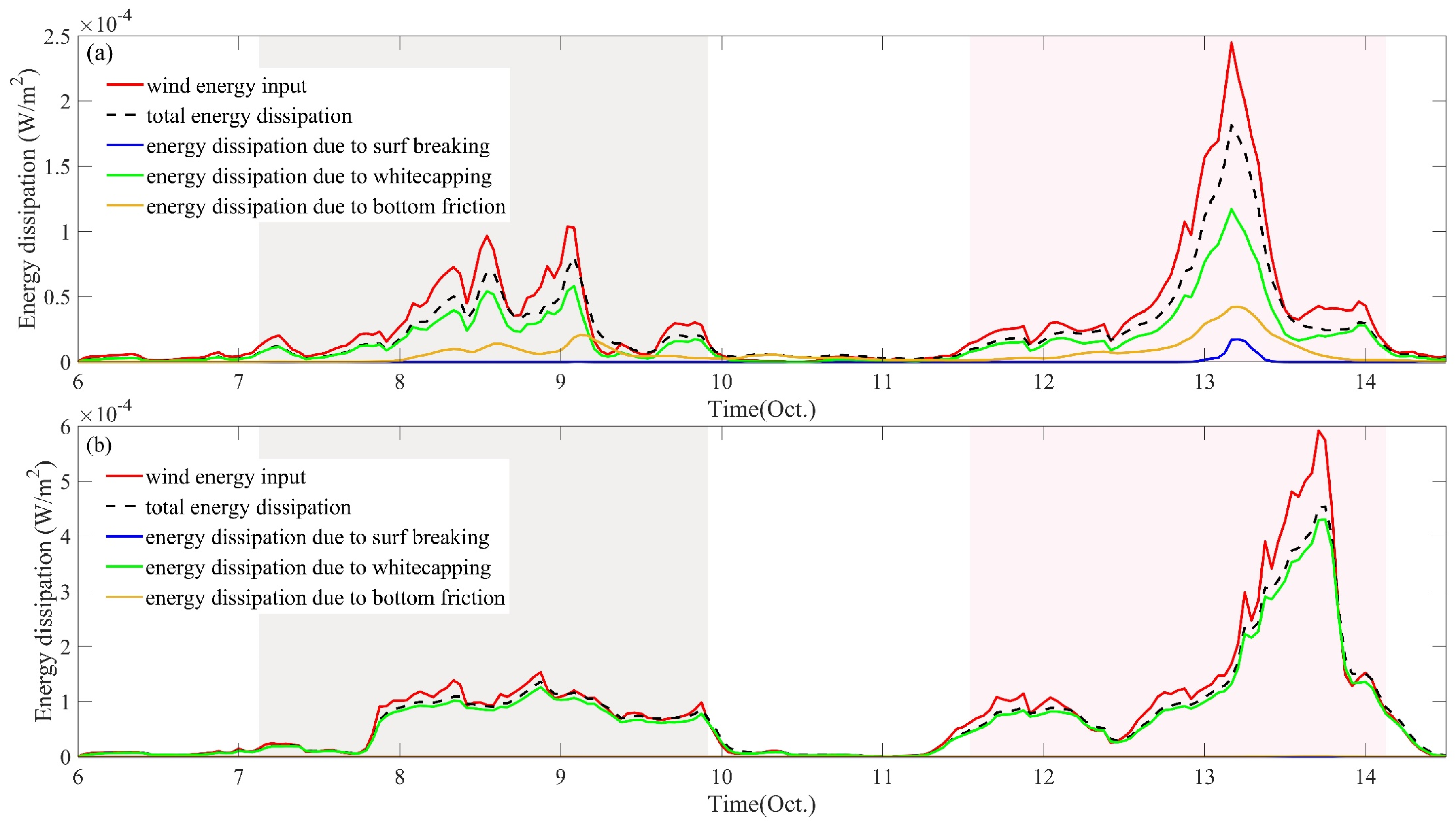
| Temperature (°C) | Wind (m/s) | Net Heat Flux (W/m2) | EPV (×10−4 m/s) | Lag Time (h) | |
|---|---|---|---|---|---|
| Nearshore (buoy station, depth < 20 m) | −2.8 | 15.05 | −418 | 4.0 | 11 |
| −3.0 | 18.88 | −535 | 5.8 | 9 | |
| Offshore (Central Beibu Gulf basin, CBGB, depth 20~100 m) | −1.6 | 15.46 | −545 | 1.28 | 26 |
| −1.2 | 20.14 | −858 | 4.00 | 11 | |
| Offshore (Northwest South China, NWSCS, depth > 100 m) | −0.7 | 13.49 | −291 | 1.33 | 28 |
| −0.8 | 18.33 | −622 | 3.33 | 29 |
| Pre-Lionrock | During Lionrock | After Lionrock (Pre-Kompasu) | During Kompasu | |||||||
|---|---|---|---|---|---|---|---|---|---|---|
| T (°C) | SWH | T (°C) | SWH | T (°C) | SWH | T (°C) | SWH | |||
| (m) | (m) | (m) | (m) | |||||||
| Nearshore (Buoy station, depth < 20 m) | 30 | 0.21 | 27.2 | 1.58 | 28.4 | 0.57 | 25.4 | 2.3 | ||
| Offshore (Central Beibu Gulf basin, CBGB, depth 20~100 m) | 30 | 1.1 | 28.4 | 3.51 | 28.5 | 0.6 | 27.3 | 5.38 | ||
| Offshore (Northwest SCS, NWSCS, depth > 100 m) | 29.5 | 2.2 | 28.8 | 3.59 | 29 | 1.52 | 28.2 | 6.39 | ||
| After Kompasu (Pre-Cold Air on the 16th) | During Cold Air on the 16th | After Cold Air on the 16th (Pre-Cold Air on the 22rd) | During-Cold Air on the 22nd | After Cold Air on the 22rd | ||||||
| T(°C) | SWH | T(°C) | SWH | T(°C) | SWH | T(°C) | SWH | T(°C) | SWH) | |
| (m) | (m) | (m) | (m) | (m) | ||||||
| Nearshore (Buoy station, depth < 20 m) | 26.6 | 0.24 | 25 | 0.82 | 26.5 | 0.23 | 24.6 | 1.15 | 25.4 | 0.32 |
| Offshore (Central Beibu Gulf basin, CBGB, depth 20~100 m) | 27.5 | 1.24 | 27 | 3.1 | 27.5 | 0.17 | 26.4 | 2.33 | 26.8 | 0.38 |
| Offshore (Northwest SCS, NWSCS, depth > 100 m) | 28.5 | 1.03 | 28.2 | 4.11 | 28.3 | 0.92 | 27.8 | 3.02 | 27.8 | 1.78 |
Disclaimer/Publisher’s Note: The statements, opinions and data contained in all publications are solely those of the individual author(s) and contributor(s) and not of MDPI and/or the editor(s). MDPI and/or the editor(s) disclaim responsibility for any injury to people or property resulting from any ideas, methods, instructions or products referred to in the content. |
© 2024 by the authors. Licensee MDPI, Basel, Switzerland. This article is an open access article distributed under the terms and conditions of the Creative Commons Attribution (CC BY) license (https://creativecommons.org/licenses/by/4.0/).
Share and Cite
Chen, X.; Xie, L.; Li, M.; Xu, Y.; Wang, Y. Response of Shallow-Water Temperature and Significant Wave Height to Sequential Tropical Cyclones in the Northeast Beibu Gulf. J. Mar. Sci. Eng. 2024, 12, 790. https://doi.org/10.3390/jmse12050790
Chen X, Xie L, Li M, Xu Y, Wang Y. Response of Shallow-Water Temperature and Significant Wave Height to Sequential Tropical Cyclones in the Northeast Beibu Gulf. Journal of Marine Science and Engineering. 2024; 12(5):790. https://doi.org/10.3390/jmse12050790
Chicago/Turabian StyleChen, Xiaotong, Lingling Xie, Mingming Li, Ying Xu, and Yulin Wang. 2024. "Response of Shallow-Water Temperature and Significant Wave Height to Sequential Tropical Cyclones in the Northeast Beibu Gulf" Journal of Marine Science and Engineering 12, no. 5: 790. https://doi.org/10.3390/jmse12050790
APA StyleChen, X., Xie, L., Li, M., Xu, Y., & Wang, Y. (2024). Response of Shallow-Water Temperature and Significant Wave Height to Sequential Tropical Cyclones in the Northeast Beibu Gulf. Journal of Marine Science and Engineering, 12(5), 790. https://doi.org/10.3390/jmse12050790







